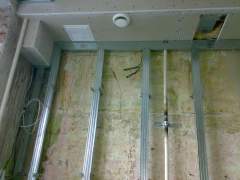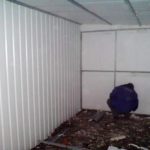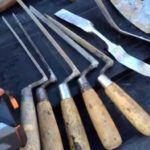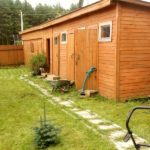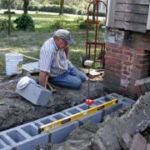How to build a false wall with your own hands – installation tips. Nobody will notice the difference with this wall.
If a question “how to build a false wall” is in your agenda now, you must first decide what you want to get as a final result. For example, if you are planning to combine the kitchen with a small living room separated by a sliding door, the ideal solution for your situation is a false wall of plasterboard. There are many situations when a fake wall allow you to create unique designs that can transform your room in a very special way.
Materials and tools
- a drill,
- screws,
- a screwdriver,
- a hammer,
- a nozzle,
- dowels,
- metal nails,
- primer,
- putty,
- wide and narrow spatulas of different sizes
The steps to start:
- the acquisition of the necessary amount of plasterboard,
- calculating it,
- finding out the data of the total area of the walls of the room.
Attention! Drywall is fragile material, so the quality of the tool, use the appropriate nozzle, do not damage the structure of the sheets of plasterboard.
Preparing the surface
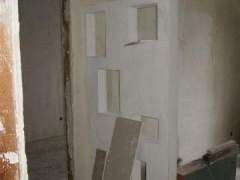 Before you start creating a false wall you should take care of certain important aspects:
Before you start creating a false wall you should take care of certain important aspects:
- prepare all the communications for the working period – after the construction of your false wall it will be very problematic to do;
- remove the entire finish of the old wall,
- seal cracks;
- process the segments with mold (if there are any) with special solutions.
The construction of the lathing
There are two variations of the wall skeleton which can be used in the construction of false walls.
- Wooden lather
Among its advantages are cheapness and ease of installation.
But the main disadvantages of this design are its unreliability and fragility. Unfortunately, to extend its service life it is necessary to use very the expensive antiseptic which can protect the timber from mold and rot, but in this situation, so, as you can see, the cheapness advantage is immediately abolished.
- Metal lathing
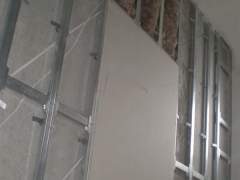 This design is characterized by reliability and durability. Its main advantage which makes this design very attractive for every person who is interested in practicality is that it can always be reused. It sounds surprisingly, but even bent the metal frame can be reused again and again, because it is always possible to be rectified. Moreover, the cost of the metal profiles is not much higher than that of timber wood ones.
This design is characterized by reliability and durability. Its main advantage which makes this design very attractive for every person who is interested in practicality is that it can always be reused. It sounds surprisingly, but even bent the metal frame can be reused again and again, because it is always possible to be rectified. Moreover, the cost of the metal profiles is not much higher than that of timber wood ones.
Important! The wooden beam is difficult to find perfectly flat, but the metal rack is quite difficult to bend to the desired shape. So, everything on Earth has its pluses and minuses.
You should start with marking the guide profile. It is mounted on the floor and on the ceiling. Then make a marking of walls on which the brackets will be installed. It should be noted that between the vertical studs a distance equal to half the width of the drywall board should be.
This condition must be followed in order the ends of the material to exactly in the middle of the profile. After this all the necessary holes are done using a drill, and then the dowels are inserted in them. The brackets and the guide profile are bolted on them.
With the fixation of the vertical racks is performed. This process should be given maximum attention, because at the end you must get the perfectly flat plane. To control the process, use a laser level or stretched string. The brackets have a plurality of holes through which you can easily adjust the vertical racks.
Installing drywall
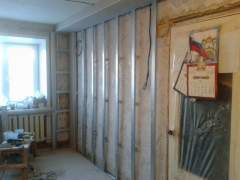 After you made sure that the frame is securely fixed, you can start the process of facing it with the help of plasterboard. Sheets of plasterboard should be prepared in advance and spread out in the room. Secure your comfort workflow by removing everything that can be removed around you.
After you made sure that the frame is securely fixed, you can start the process of facing it with the help of plasterboard. Sheets of plasterboard should be prepared in advance and spread out in the room. Secure your comfort workflow by removing everything that can be removed around you.
It would be the best way to start from the window or from the doorway. When you work with your first sheet of plasterboard, you should not drill out the holes for screws with a drill, it is better to use screws with a drill at the end of screwing them at intervals of not less than 8 inches.
After the work with plasterboard is finished, make sure that all joints are carefully treated and the overall surface has become even. The primer is used traditionally. The primer is applied by a roller to the entire surface of the wall. This the final stage before the applying of the finishing putty.
After the complete drying of the putty all the seams between sheets must be treated with sandpaper with fine abrasive. After that the surface is coated again with the primer. Now your false wall is ready.
We hope this article helped you to get the necessary information on how to build a fake wall.
Questions and answers on the building of false walls
Question: I can not decide what material to choose for the frame of the fake wall? I am considering both metal frame and wooden frame. What do you recommend?
Answer: It does not matter with what frame will be made of plasterboard false wall with their own hands. It will not affect its quality. However, it is easier to work with a metal profile. It does not need to be treated with special protective compounds as wood. Yes, and to get wooden bars with slats is much more difficult. Therefore, it is used extremely rarely. There is no need to invent a bicycle, use metal profile, like everyone else.
Question: After I made a false wall of drywall – what next?
Answer: You can not leave a false wall of drywall in the form in which it turned out. It should be prepared for finishing, be it wallpaper, tile, paint or something else. The first thing to do is to putty the heads of the self-tapping screws and the joints of the drywall sheets. Batten caps putty, among other things, to make the color of the wall monochrome. Also, such a procedure protects them from rusting, which is certainly unlikely in normal conditions.
The joints between the sheets are primed, if they are trimmed. It will not be a mistake to prime all joints, so the putty will hold well. After the drying of the primer on the joints applied finishing putty, and then the joints are put on reinforcing tape (paper or strips). Tape smoothing spatula, so it sticks, as well as to remove excess putty. This tape makes the joints more durable and prevents cracks from appearing.
After the putty dries, the entire false wall of drywall is primed twice. After that, it is completely putty (it is acceptable to apply two layers of putty to get a perfectly flat surface). After the mortar dries, the false wall is treated with sandpaper, which helps to remove any remaining irregularities. That’s it, the false wall is ready for finishing.
Question: What is the main purpose of a false wall? When is such a wall necessary?
Answer: A false wall is built by a person for several reasons, but they are all directly related to the need to hide something behind it. If you list item by item, among the most common reasons for a false wall in a house or apartment are the following reasons.
- Warming or soundproofing of the walls – in this case, different kinds of heat insulation materials are hidden behind the false wall panels. In most cases, mineral wool.
- Laying of hidden communications. If electrical cables can still be cut into the existing concrete or brick wall, but it is impossible to do so with water, sewer and ventilation pipes due to their large diameter.
- Installation of hidden mechanisms will also require the installation of a false wall. For example, do not do without its help in the case of installation of cassette sliding doors, which in the closed position are completely hidden in the false wall.
- Decorative purposes. Quite often, using the false wall, various kinds of functional niches are made in the interior of the room.
- Alignment of existing walls, when they have a large degree of curvature.
In addition, to the concept of a false wall, modern builders also refer to the already long familiar to all people interior partitions made of plasterboard – they do not carry the load, but with the task of dividing the living space into rooms quite cope.
